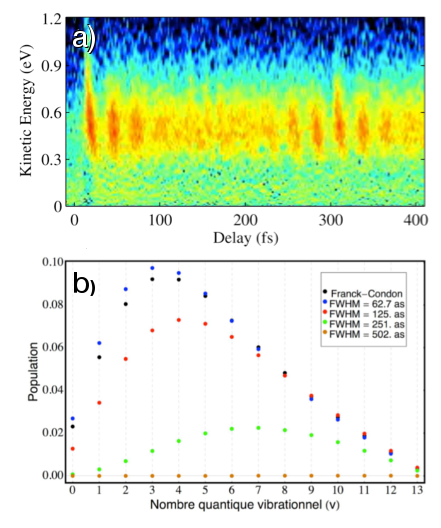Accueil > Équipes scientifiques > Dynamiques et Interactions : Rayonnement, Atomes, Molécules (DIRAM) > Processus moléculaires contrôlés par des champs laser intenses > Full electro-nuclear dynamics of molecules irradiated by intense, ultra short laser pulses
Full electro-nuclear dynamics of molecules irradiated by intense, ultra short laser pulses
Jérémy Viau Trudel, PhD in progress (2nd year), Co-supervised doctoral thesis France (O. Atabek, Université Paris-Sud) / Canada (T.T. Nguyen-Dang, Université Laval)
Intense and ultra short laser induced molecular photofragmentation (ionization and dissociation) is studied referring to multielectronic ab-initio dynamical calculations. Electronic and nuclear dynamics are taken into account on an equal footing through a full quantum many particle model accurately describing electron correlations [1]. In
particular, this allows a dynamical approach for the ionization step of pump (attosecond, XUV)- probe (femtosecond, intense IR) dissociative ionization experiments.The signatures of electron correlation and nuclear motions are examined for a class of observables such as photoionization and photodissociation spectra, high order harmonic emission, photo-double ionization (sequential or non sequential) laser
induced electron diffraction, molecular orbital tomography.
As an illustrative example, the figure displays (in panel a) an experimental kinetic energy release photodissociation spectrum of protons originating from the dissociative ionization of H2 [2]. Its quantitative interpretation relies on an accurate attosecond time scale dynamical calculation for the ionization step. This leads, for different pump pulse durations, to H2+ ion vibrational distributions which may markedly depart from the commonly refereed Franck-Condon one (panel b) [3]. It is precisely such calculations that could open the way for understanding, imaging and controlling photofragment distributions resulting from delay controlled two-color pump-probe spectroscopy.

[2] F. Kelkensberg et al., Phys.Rev.Lett., 103, 123005 (2009)
Dans la même rubrique :
- Processus moléculaires contrôlés par des lasers intenses : Dynamiques électronique et nucléaire
- Processus moléculaires en présence de champs intenses : Résonances et contrôle
- Explosion coulombienne de induite par une impulsion laser intense sub-10 fs
- Diffraction électronique femtoseconde
- Dynamique électronique et nucléaire de molécules exposées à des impulsions laser ultra-brèves et intenses


